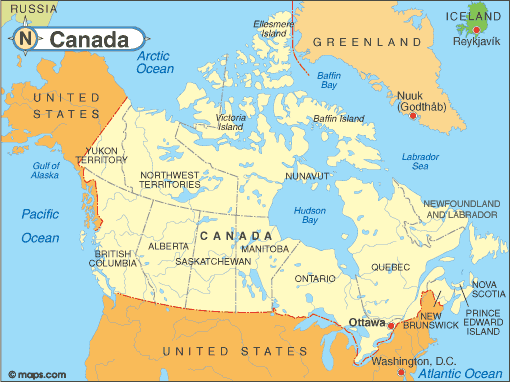Canada Map: Regions, Geography, Facts & Figures
Canada, the second largest country in the world, is located in North America and shares borders with the contiguous U.S. states to the south and Alaska to the northwest. It is a vast nation with diverse landscapes, vibrant cities, and unique cultural experiences. This guide provides an overview of Canada's geography, major cities, and attractions, as well as useful resources like the map of Canada and its provinces and territories.
If you want to discover more in-depth information on Canada as a country, check out our Canada Profile!
Test your country knowledge with our Canadian geography quiz, How Well Do You Know Canada?

Province Maps: Canada
Territory Maps: Canada
Canada Facts: History
Canada's history dates back over 10,000 years when Indigenous peoples first inhabited the land. European exploration began in the late 15th century, with the French and British eventually establishing colonies. Canada gained independence from Britain in 1867 and has since developed into a culturally diverse and prosperous nation. Today, Canada is known for its natural beauty, friendly people, and a strong economy.
Canada Facts: Geography
Canada is the second-largest country in the world and has a vast and diverse geography. It has a mix of mountains, forests, lakes, and plains. The Rocky Mountains run through western Canada, while the Canadian Shield covers most of eastern and central Canada. The country has thousands of lakes, including the Great Lakes, and many rivers, including the St. Lawrence and the Mackenzie. The country also has a long coastline on three oceans: the Atlantic, Arctic, and Pacific.
Canada Facts: Tourist Attractions
Canada has many popular tourist attractions spread across the atlas, including the famous Niagara Falls, the stunning Canadian Rockies, and the charming old town of Quebec City. The country also has many cultural attractions, such as the Canadian Museum of History in Ottawa and the Royal Ontario Museum in Toronto. Other popular activities include skiing in Banff, whale watching in Tofino, and visiting the historic Fortress of Louisbourg in Nova Scotia.

People Also Search For...
Other online explorers of this country also commonly ask the following questions.
What Is Canada Famous For?
Canada is known for its natural beauty, with vast and diverse geography that includes mountains, forests, lakes, and plains. The country is also known for its friendly people, multiculturalism, and strong economy. Some of its most famous attractions include Niagara Falls, the Canadian Rockies, and the charming old town of Quebec City.
What Are the 13 Provinces of Canada in Order?
Canada is comprised of ten provinces and three territories, each with its own distinct character and attractions. From the Atlantic Ocean in the east to the Pacific Ocean in the west, and from the Arctic Ocean in the north to the United States border in the south, Canada spans six time zones and covers a vast area.
- British Columbia: Home to the capital city of Victoria and major city Vancouver, it is known for its stunning natural landscapes, including national parks.
- Alberta: Calgary and Edmonton are the largest cities, and it is famous for its Rocky Mountains and the picturesque Banff National Park.
- Saskatchewan: Regina is the capital, and it is known for its vast prairies and agricultural land.
- Manitoba: Winnipeg is the capital, and it is characterized by its diverse wildlife, lakes, and forests.
- Ontario: The most populous province with Toronto as its capital and Ottawa, the capital city of Canada.
- Quebec: Montreal and Quebec City are the largest cities, and it is the largest province in terms of land area, with a predominantly French-speaking population.
- Newfoundland and Labrador: St. John's is the capital, and it is the easternmost province with a rugged coastline and rich history.
- New Brunswick: Fredericton is the capital, and it is known for its picturesque landscapes and coastal beauty.
- Nova Scotia: Halifax is the capital, and it boasts a rich maritime history and stunning coastal scenery.
- Prince Edward Island: Charlottetown is the capital, and it is famous for its red-sand beaches and literary heritage.
- Yukon: Whitehorse is the capital, and it is known for its pristine wilderness and the Klondike Gold Rush history.
- Northwest Territories: Yellowknife is the capital, and it is home to diverse indigenous cultures and the breathtaking Aurora Borealis.
- Nunavut: Iqaluit is the capital, and it is Canada's newest and largest territory, known for its Inuit culture and Arctic landscapes.
|
|








